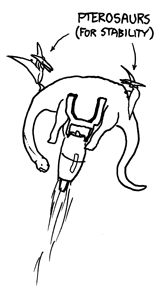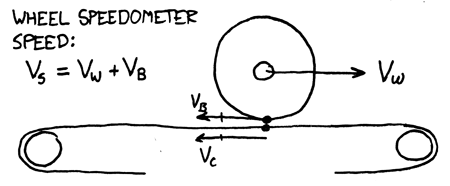by Randall Munroe of xkcd. Originally posted at blog.xkcd.com; reposted here for language sensitive audiences.
—
Feynman used to tell a story about a simple lawn-sprinkler physics problem. The nifty thing about the problem was that the answer was immediately obvious, but to some people it was immediately obvious one way and to some it was immediately obvious the other. (For the record, the answer to Feynman problem, which he never tells you in his book, was that the sprinkler doesn’t move at all. Moreover, he only brought it up to start an argument to act as a diversion while he seduced your mother in the other room.)
The airplane/treadmill problem is similar. It contains a basic ambiguity, and people resolve it one of a couple different ways. The tricky thing is, each group thinks the other is making a very simple physics mistake. So you get two groups each condescendingly explaining basic physics and math to the other. This is why, for example, the airplane/treadmill problem is a banned topic on the xkcd forums (along with argument about whether 0.999… = 1).
Imagine a 747 is sitting on a conveyor belt, as wide and long as a runway. The conveyor belt is designed to exactly match the speed of the wheels, moving in the opposite direction. Can the plane take off?
The practical answer is “yes”. A 747’s engines produce a quarter of a million pounds of thrust. That is, each engine is powerful enough to launch a brachiosaurus straight up (see diagram). With that kind of force, no matter what’s happening to the treadmill and wheels, the plane is going to move forward and take off.
But there’s a problem. Let’s take a look at the statement “The conveyor belt is designed to exactly match the speed of the wheels”. What does that mean?
Well, as I see it, there are three possible interpretations. Let’s consider each one based on this diagram:
- vB=vC: The belt always moves at the same speed as the bottom of the wheel. This is always true if the wheels aren’t sliding, and could simply describe a treadmill with no motor. I haven’t seen many people subscribe to this interpretation.
- vC=vW: That is, if the axle is moving forward (relative to the ground, not the treadmill) at 5 m/s, the treadmill moves backward at 5 m/s. This is physically plausible. All it means is that the wheels will spin twice as fast as normal, but that won’t stop the plane from taking off. People who subscribe to this interpretation tend to assume the people who disagree with them think airplanes are powered by their wheels.
- vC=vW+vB: What if we hook up a speedometer to the wheel, and make the treadmill spin backward as fast as the speedometer says the plane is going forward? Then the “speedometer speed” would be vW+vB — the relative speed of the wheel over the treadmill. This is, for example, how a car-on–a-treadmill setup would work. This is the assumption that most of the ‘stationary plane’ people subscribe to. The problem with this is that it’s an ill-defined system. For non-slip tires, vB=vC. So vC=vW+vC. If we make vWpositive, there is no value vC can take to make the equation true. (For those stubbornly clinging to vestiges of reality, in a system where the treadmill responds via a PID controller, the result would be the treadmill quickly spinning up to infinity.) So, in this system, the plane cannot have a nonzero speed. (We’ll call this the “JetBlue” scenario.)
But if we push with the engines, what happens? The terms of the problem tell us that the plane cannot have a nonzero speed, but there’s no physical mechanism that would plausibly make this happen. The treadmill could spin the wheels, but the acceleration would destroy them before it stopped the plane. The problem is basically asking “what happens if you take a plane that can’t move and move it?” It might intrigue literary critics, but it’s a poor physics question.
So, people who go with interpretation #3 notice immediately that the plane cannot move and keep trying to condescendingly explain to the #2 crowd that nothing they say changes the basic facts of the problem. The #2 crowd is busy explaining to the #3 crowd that planes aren’t driven by their wheels. Of course, this being the internet, there’s also a #4 crowd loudly arguing that even if the plane was able to move, it couldn’t have been what hit the Pentagon.
All in all, it’s a lovely recipe for an internet argument, and it’s been had too many times. So let’s see if we can avoid that. I suggest posting stories about something that happened to you recently, and post nice things about other peoples’ stories. If you’re desperate to tell me that I’m wrong on the internet, don’t bother. I’ve snuck onto the plane into first class with the #5 crowd and we’re busy finding out how many cocktails they’ll serve while we’re waiting for the treadmill to start. God help us if, after the fourth round of drinks, someone brings up the two envelopes paradox.
—
Munroe’s website is typically licensed under a Creative Commons Attribution-NonCommercial 2.5 License; that license is assumed here.





